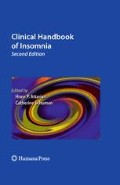Abstract
This chapter explores the causes for insomnia in teens: delayed sleep phase syndrome, insomnia as a symptom of psychiatric disorders, and insomnia as a symptom of substance abuse. Other forms of insomnia occur in the adolescent population. These include psychophysiologic insomnia, neuro-endocrine/hormonal influences on sleep patterns, which pertain to women’s health, restless legs syndrome, insomnia after traumatic brain injury, medical conditions including hyperthyroidism, and genetic disorders.
Access this chapter
Tax calculation will be finalised at checkout
Purchases are for personal use only
References
Schrader H, Bovim G, Sand T (1993) The prevalence of delayed and advanced sleep phase syndromes. J Sleep Res 2(1):51–55
Ancoli-Israel S, Roth T (1999) Characteristics of insomnia in the United States: results of the 1991 national sleep foundation survey. I. Sleep 22 Suppl 2:S347–S353
Pandi-Perumal SR, Smits M, Spence W, Srinivasan V, Cardinali DP, Lowe AD, Kayumov L (2007) Dim light melatonin onset (DLMO): a tool for the analysis of circadian phase in human sleep and chronobiological disorders. Prog Neuropsychopharmacol Biol Psychiatry 31(1):1–11
Morgenthaler TI, Lee-Chiong T, Alessi C, Friedman L, Aurora RN, Boehlecke B, Brown T, Chesson AL, Jr, Kapur V, Maganti R, Owens J, Pancer J, Swick TJ, Zak R, Standards of Practice Committee of the American Academy of Sleep Medicine (2007) Practice parameters for the clinical evaluation and treatment of circadian rhythm sleep disorders. an American academy of sleep medicine report. Sleep 30(11):1445–1459
Fremont WP (2003) School refusal in children and adolescents. Am Fam Physician 68(8):1555–1560
Thapan K, Arendt J, Skene DJ (2001) An action spectrum for melatonin suppression: evidence for a novel non-rod, non-cone photoreceptor system in humans. J Physiol 535(Pt 1):261–267
Wright HR, Lack LC, Kennaway DJ (2004) Differential effects of light wavelength in phase advancing the melatonin rhythm. J Pineal Res 36(2):140–144
Deacon S, Arendt J (1995) Melatonin-induced temperature suppression and its acute phase-shifting effects correlate in a dose-dependent manner in humans. Brain Res 688(1–2):77–85
Dumortier G, Welniarz B, Sauvebois C, Medjdoub H, Friche H, Siad N, Degrassat K (2005) Prescription of psychotropic drugs in pediatry: approved indications and therapeutic perspectives. Encéphale 31(4 Pt 1):477–489
Liu X, Buysse DJ (2006) Sleep and youth suicidal behavior: a neglected field. Curr Opin Psychiatry 19(3):288–293
Hall RC, Platt DE, Hall RC (1999) Suicide risk assessment: a review of risk factors for suicide in 100 patients who made severe suicide attempts. evaluation of suicide risk in a time of managed care. Psychosomatics 40(1):18–27
Goetting MG, Reijonen J (2007) Pediatric insomnia: a behavioral approach. Prim Care 34(2):427–435; abstract x
Anbar RD, Slothower MP (2006) Hypnosis for treatment of insomnia in school-age children: a retrospective chart review. BMC Pediatr 6:23
Richter NC (1984) The efficacy of relaxation training with children. J Abnorm Child Psychol 12(2):319–344
Freedman R, Papsdorf JD (1976) Biofeedback and progressive relaxation treatment of sleep-onset insomnia: a controlled, all-night investigation. Biofeedback Self Regul 1(3):253–271
Nicassio PM, Boylan MB, McCabe TG (1982) Progressive relaxation, EMG biofeedback and biofeedback placebo in the treatment of sleep-onset insomnia. Br J Med Psychol 55(Pt 2):159–166
Shibley HL, Malcolm RJ, Veatch LM (2008) Adolescents with insomnia and substance abuse: consequences and comorbidities. J Psychiatr Pract 14(3):146–153
Kryger M, Roth T, Dement W (2000) Principles and practice of sleep medicine. W.B. Saunders, Philadelphia
Brower KJ, Aldrich MS, Robinson EA, Zucker RA, Greden JF (2001) Insomnia, self-medication, and relapse to alcoholism. Am J Psychiatry 158(3):399–404
Brower KJ (2001) Alcohol’s effects on sleep in alcoholics. Alcohol Res Health 25(2):110–125
Diagnostic Classification Steering Committee (1990) The international classification of sleep disorders: diagnostic and coding manual. American Sleep Disorders Association, Rochester, MN
O’Brien MC, McCoy TP, Rhodes SD, Wagoner A, Wolfson M (2008) Caffeinated cocktails: energy drink consumption, high-risk drinking, and alcohol-related consequences among college students. Acad Emerg Med 15(5):453–460
Johnson EO, Breslau N (2001) Sleep problems and substance use in adolescence. Drug Alcohol Depend 64(1):1–7
Currie SR, Clark S, Rimac S, Malhotra S (2003) Comprehensive assessment of insomnia in recovering alcoholics using daily sleep diaries and ambulatory monitoring. Alcohol Clin Exp Res 27(8):1262–1269
Teplin D, Raz B, Daiter J, Varenbut M, Tyrrell M (2006) Screening for substance use patterns among patients referred for a variety of sleep complaints. Am J Drug Alcohol Abuse 32(1):111–120
Author information
Authors and Affiliations
Editor information
Editors and Affiliations
Rights and permissions
Copyright information
© 2010 Springer Science+Business Media, LLC
About this chapter
Cite this chapter
Garcia, J. (2010). Insomnia in Teens. In: Attarian, H., Schuman, C. (eds) Clinical Handbook of Insomnia. Current Clinical Neurology. Humana Press, Totowa, NJ. https://doi.org/10.1007/978-1-60327-042-7_7
Download citation
DOI: https://doi.org/10.1007/978-1-60327-042-7_7
Published:
Publisher Name: Humana Press, Totowa, NJ
Print ISBN: 978-1-60327-033-5
Online ISBN: 978-1-60327-042-7
eBook Packages: MedicineMedicine (R0)

